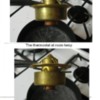I put in the VDO gauges and stored away the Veglias. I haven't seen these kind of issues with them. The Veglias lie a lot and the sender is a Ford sender and the calibration to the Veglia is off a little.
Symptoms you are describing are associated with a bad thermostat, or a thermostat on it's way out. It is the fuseable link to the system, i.e., cheap. Some only last a couple of years. I'd change it first before I did anything else and see if it fixes the issue.
I'd recommend running a 180 thermostat. It's a compromise between 160 and 192.
If you check the thermostat, verify that you have the unique Cleveland style in. There are still mechanics who don't know the difference and will swear to you they put the right one in there.
Also, if the water pump was changed, there are some like the Wieand which do not have the bypass hole in them by design. You do not want that in the Pantera.
You want the bypass. Do not mess around with modifying the original design system. It is strange but does work the way it was designed.
Capacity of the original radiator is fine. It can be improved by making it a true crossflow but that isn't imperative. It will work as originally designed and built.
There was a design change on the goose neck in the system from the early cars. The early design was causing some issues like this.
Inexplicably some Panteras have more problems then others in bleeding the air out of the system at the radiaor. I wouldn't be shocked if your car was one of them. Sometimes the only thing you can do is stand the car on its nose to bleed the system or install a bleeder near the radiator. Wait till you hear the air hissing out. You'll be shocked.
If you are running the original steel under car radiator "pipes" it isn't impossible for them to have internal corrosion and be flaking off rust that is working like a flapper valve in the radiator. It's not a bad idea to change them out to the stainless.
Got my cars 40 years. Married 26. Your call on the lady or the tiger? By now, she should be wise enough to leave you and the Pantera alone? The cars look as good as they did 40 years ago and can be restored. She doesn't, and can't. Food for thought?




